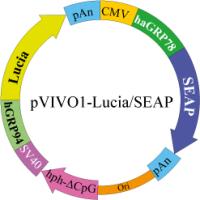pVIVO1-mcs
-
Cat.code:
pvivo1-mcs
- Documents
ABOUT
Dual expression plasmids for in vivo experiments - Two Multiple cloning sites (MCS)
pVIVO-MCS plasmids are specifically designed for in vivo experiments. They allow for strong and sustained co-expression of two genes of interest.
These plasmids contain two separate transcription units (TU), each consisting of a strong promoter and an efficient polyadenylation signal.
pVIVO-MCS plasmids contain two multiple cloning sites (MCS) for the convenient cloning of cDNAs. Both MCS are located downstream of specific composite promoters, allowing high levels of expression of the cloned transgenes in tumors. Expression may be achieved in vivo and in vitro in transient transfection experiments.
pVIVO-MCS plasmids carry the hygromycin resistance gene for selection and amplification in E. coli. They do not contain a selectable marker for mammalian cells.
Choose between the provided backbones pVIVO1 and pVIVO2:
| Plasmid | Promoters | Expression | MCS1 | MCS2 |
|---|---|---|---|---|
| pVIVO1-MCS | Human GRP94 & hamster GRP78 | Stress inducible (tumor-specific) | 5’- Age I, Bsp HI, Xba I, Hind III, Bst 1107I, Avr II -3’ | 5’- Ngo MI, Nco I, Bgl II, Eco RI, Nhe I-3’ |
| pVIVO2-MCS | Human Ferritin H & Ferritin L | Constitutive (ubiquitous) | 5’- Bsp HI, Xba I, Bsr GI, Bst 1107I, Avr II -3’ | 5’- Nco I, Bam HI, Eco RI, Eco RV, Nhe I-3’ |
All products are for research use only, and not for human or veterinary use.
SPECIFICATIONS
Specifications
Simultaneous expression in vivo of two genes for animal models
Plasmid construct has been confirmed by restriction analysis and sequencing.
CONTENTS
Contents
-
Product:pVIVO1-mcs
-
Cat code:pvivo1-mcs
-
Quantity:20 µg
1 ml of Hygromycin B Gold at 100 mg/ml
Shipping & Storage
- Shipping method: Room temperature
- -20°C
- Avoid repeated freeze-thaw cycles
Storage:
Caution:
Details
• haGRP78 and hGRP94 prom: The hamster GRP78 and human GRP94 promoters drive weak levels of expression in normal conditions and are induced in stress conditions prevailing inside tumors, such as glucose deprivation and hypoxia. Within the tumor micro-environment, the GRP promoters yield persistent expression, whereas the activity of viral promoters declines rapidly.
• hFerH and hFerL composite promoters: Ferritin is a 24-subunit protein composed of two subunit types, termed H (heavy) and L (light). Ferritin is ubiquitously expressed. To eliminate the iron regulation of the ferritin promoters, the 5’UTR of FerH and FerL have been replaced by the 5’UTR of the mouse and chimpanzee elongation factor 1 (EF1) genes, respectively.
• SV40 enhancer, which is comprised of a 72-base-pair repeat, allows the enhancement of gene expression in a large host range. The enhancement varies from 2-fold in non-permissive cells to 20-fold in permissive cells. Furthermore, the SV40 enhancer is able to direct nuclear localization of plasmids.
• CMV enhancer: The major immediate early enhancer of the human cytomegalovirus (HCMV) is composed of unique and repeated sequence motifs. The HCMV enhancer can substitute for the 72-bp repeats of SV40 and is severalfold more active than the SV40 enhancer.
• SV40 pAn: the Simian Virus 40 late polyadenylation signal enables efficient cleavage and polyadenylation reactions resulting in high levels of steady-state mRNA.
• pMB1 ori: a minimal E. coli origin of replication to limit vector size, but with the same activity as the longer Ori.
• EM7 is a bacterial promoter that enables the constitutive expression of the antibiotic resistance gene in E. coli.
• Hygro-ΔCpG is a new allele of the hph gene conferring resistance to hygromycin B. In order to reduce the immunogenicity of this bacterial gene all CpG motifs have been removed by chemically synthesizing the gene. The Hygro-ΔCpG gene allows the selection of E. coli clones transformed with a pVIVO plasmid.
Note: Stable transfection of mammalian clones cannot be performed due to the absence of a eukaryotic promoter upstream of the Hygro-ΔCpG gene.
• Term: The E. coli rps O terminator allows efficient transcription termination of the Hygro-ΔCpG gene.
• EF1 pAn is a strong polyadenylation signal.
• MCS: Each multiple cloning site contains several restriction sites that are compatible with many other enzymes, thus facilitating cloning:
pVIVO1: - MCS1 contains the following restriction sites: Age I, Bsp HI, Xba I, Hind III, Bst 1107I, and Avr II.
- MCS2 contains the following restriction sites: NgoM I, Nco I, Bgl II, EcoR I, and Nhe I
pVIVO2: - MCS1 contains the following restriction sites: Bsp HI, Xba I, BsrG I, Bst 1107I, and Avr II.
- MCS2 contains the following restriction sites: Nco I, BamH I, EcoR I, EcoR V, and Nhe I
DOCUMENTS
Documents
Technical Data Sheet
Plasmid Sequence
Safety Data Sheet
Certificate of analysis
Need a CoA ?

